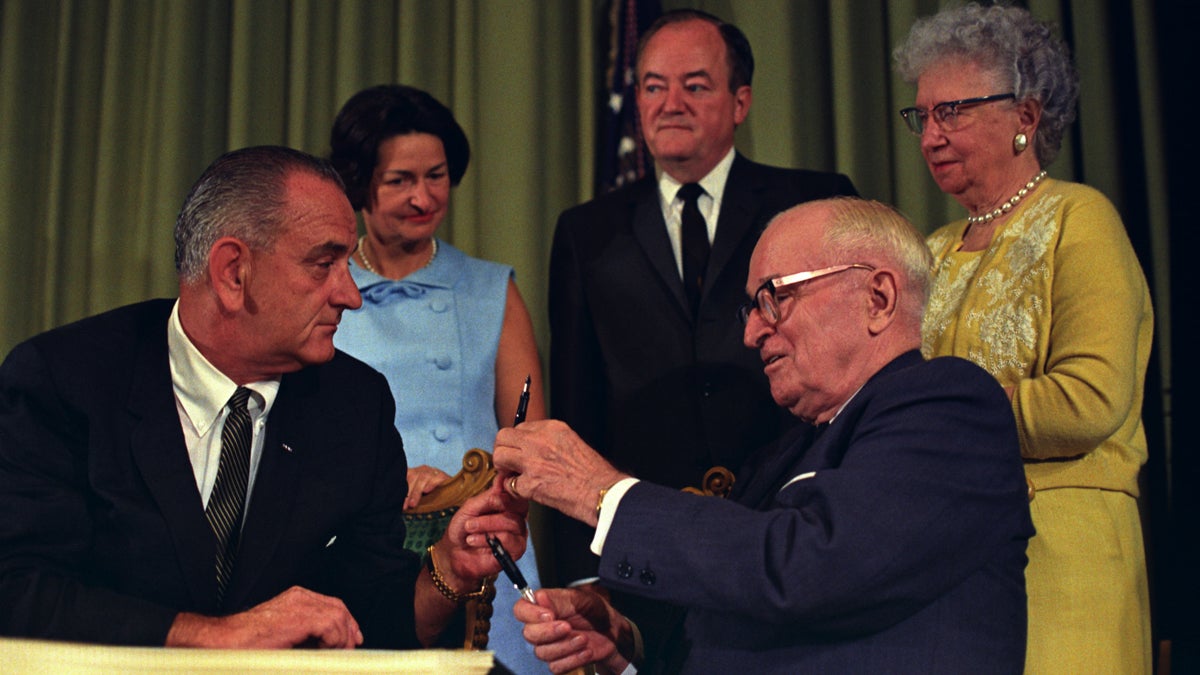As health program turns 50, study finds long-term benefits of childhood Medicaid

President Lyndon B. Johnson signed the bill creating Medicare and Medicaid at the library of former President Harry Truman, who was in attendance, on July 30, 1965. (Photo courtesy of Truman Library)
The twin pillars of government health care coverage were created 50 years ago with a few strokes of the pen as President Lyndon Johnson signed amendments to the Social Security Act that brought about Medicare and Medicaid.
Back then, Medicare got most of the fanfare. The program, primarily for Americans 65 and older, is federally funded and gets lots of love from people of all political stripes. Medicaid, however, is more complicated and less popular, but advocates say its reputation growing.
Individual states and the federal government jointly fund Medicaid.
“Because Medicaid touches so many lives through long-term care services, through children and families, through people with disabilities, the vast majority of Americans know someone who’s been on Medicaid,” said Joan Alker, director of the Center for Children and Families at Georgetown University.
After culling results from studies on the Medicaid program, the Georgetown researchers report that adults who were enrolled in Medicaid as children aren’t just healthier as adults — but they also achieve greater academic and financial success.
Medicaid is a good long-term investment, Alker said.
“Both because these folks are earning more and paying more taxes, and also because their health care costs are going to be lower because they are going to be healthier when they grow up,” she said.
“The problem with studies like this — all economists do these kinds of studies — they’re simply using statistical techniques to say that one thing correlated with, not necessarily caused by, correlated with something else,” said Joe Antos, an economist with the American Enterprise Institute in Washington, D.C.
“They did isolate the effect of having Medicaid,” Alker said about the studies referenced in the Georgetown report.
Antos said Medicaid can reduce financial barriers to care for low-income people, but the program has limits.
“Mom still has to take the kid into the doctor or to the clinic to get the shot,” he said. “For that matter, Mom has to take herself in.”
“Really the Medicaid program is addressing the part of the population where, for most people, the issue is not just health, it’s poverty,” Antos said. “Medicaid is an important cog in a very complicated wheel.”
Sizi0ng up the challenges
This week many consumer-health advocates and policy analysts are marking Medicaid’s anniversary by weighing in on the program’s strengths and weaknesses.
The Affordable Care Act gave millions more Americans access to Medicaid, and now about 70 million are enrolled. That’s nearly one in four Americans.
Noni West is with the Council of Southeast Pennsylvania that helps people recovering from drug and alcohol addiction. She’s a Medicaid supporter, in part, she said because the program pays for some certified addiction recovery programs in the community that are often not covered by private health plans.
Pro-Act, the recovery support arm of the coalition, uses trained peer mentors to counsel and lead people trying to shake an addiction.
“We have community centers where people can come in, and we have specialists who will help them develop plans for their recovery, help them develop life skills,” West said.
Medicaid is also a boon for people with a long history of addiction because they often have chronic health problems they need to address once their addiction is under control, she said.
In an analysis from Kaiser Health News, reporter Phil Galewitz outlines five challenges facing Medicaid at 50. Big among them is the rising demand for long-term care.
“While Medicaid is often typecast as helping poor, inner-city families, it’s also the only safety net for millions of middle-class people who need long-term care at home or in nursing homes. More than 60 percent of nursing home residents rely on Medicaid for assistance,” Galewitz writes.
In Pittsburgh, the Consumer Health Coalition advocates for consumers and applauds Pennsylvania’s recent decision to expand it Medicaid program.
“I like to call it the ‘exhale’ of knowing you have health care coverage,” said Rev. Jo Snyder, who directs Advocacy and Consumer Engagement for the coalition.
She says stereotypes about people living in poverty dog Medicaid’s reputation — “they’re abusing the system, they’re freeloading” — and are “ridiculous.”
That stigma may keep people from getting the care they need, she said.
In the future, Snyder hopes Medicaid will make it easier for consumers to navigate the system — right now it seems unnecessarily complicated, she said, and the benefits can be hard to understand for people new to the program.
WHYY is your source for fact-based, in-depth journalism and information. As a nonprofit organization, we rely on financial support from readers like you. Please give today.

